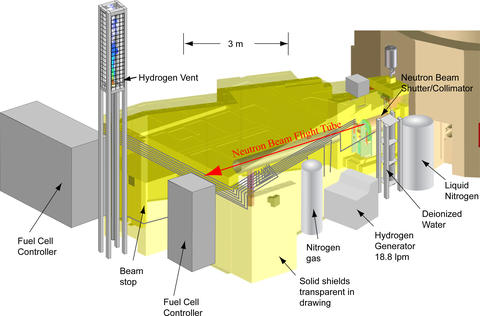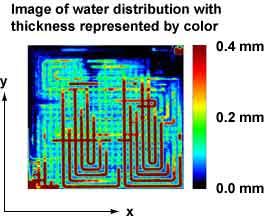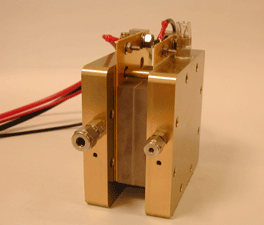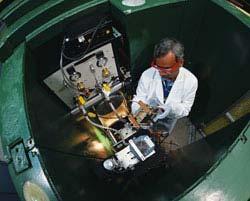Neutron Imaging Facility (NIF)

Neutron Imaging, an Essential Tool for the Hydrogen Economy
The problem that the NIST Neutron Imaging Facility (NIF) can address that directly impacts the progress of the Hydrogen Economy is the issue of flooding and water management in hydrogen fuel cells. The development of robust and efficient fuel cell designs requires a non-destructive tool that can probe and evaluate the production of water in hydrogen powered fuel cells. Here at the NIST Center for Neutron Research a new, advanced fuel cell imaging facility has been built to do just this. This facility provides the necessary infrastructure for fuel cell manufacturers and university users to perform fuel cell experiments on both commercial grade and smaller research grade fuel cells and stacks. This facility allows visualization of water production and removal in operating fuel cells in conditions simulating the real world artic freeze/thaw and desert heat environments. The current NIF is a second generation of neutron imaging facilities built here at NIST. This capability has recently received independent credit for the impact it is providing to fuel cell developers from the National Academies report, which states that: "The NIST effort ... is a considerable achievement and one of the most significant analytical advances in the membrane fuel cell realm in decades. The NIST facility offers the entire fuel cell community unique research opportunities that previously eluded them."
Most recently this capability at NIST has been highlighted in this excerpt from the President's American Competitiveness Initiative.


Overcoming Technological Barriers to the Hydrogen Economy

The "hydrogen economy" would use domestic sources of energy to create hydrogen gas, which in turn could be used as a transportation fuel. Other possibilities include using hydrogen-bearing fuels such as alcohol or natural gas as potentially economical and long-lasting sources of electrical power for portable electronics such as cell phones and laptop computers, or even for powering buildings that are remote from power lines. Many technical and economic hurdles remain before these technologies can be made widely available. Reducing costs, improving efficiencies, and making the technology reliable enough for everyday use will all be important. If these technical goals are achieved, the broad use of hydrogen as a fuel may prove to have environmental advantages as well. The Department of Energy is leading the President’s Hydrogen Fuel Initiative to achieve these goals.
NIST research helps support this developing technology in many ways. Projects currently under way at NIST are providing measurements, data, and technologies needed to develop and test the performance of hydrogen-based power sources and to improve the efficiency of hydrogen production methods.
A new imaging facility at the NIST Center for Neutron Research provides a rare portal for visualizing water and hydrogen transport in fuel cells. Neutrons reveal how water forms and moves while a fuel cell is operating. Mastering the combined challenge of managing incoming humidity, proper hydration of fuel cell membranes, and the handling of water byproducts is essential to the development of fuel cells that are practical for automotive and residential applications as well as portable devices.
Scientific Opportunities/Applications
Time-lapse movie of water slugs moving in a fuel cell from 2002, the time-lapse is due to a 4 s image download time; presently NIST neutron imaging detectors are capable of acquiring images at frame rates greater than 30 Hz. In order to distinguish anode (hydrogen-side) from cathode (air-side) in this measurement of the in-plane water content, the anode channels are predominately in the vertical direction while the cathode channels are horizontal. The operating conditions of the cell resulted in a large amount of back diffusion from the cathode side (where product water is formed) to the anode.

